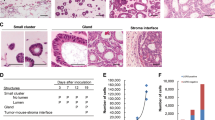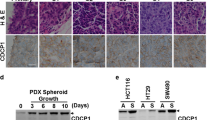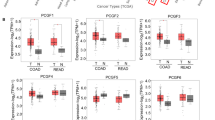Abstract
Colorectal tumor-initiating cells (CT-ICs) have self-renewal capabilities and have an important role in tumorigenesis, metastasis, recurrence and treatment resistance in colorectal cancer. Multiple cell-surface molecules targeting CT-ICs, possibly representing different CT-IC subpopulations, have been reported. However, whether new surface markers exist, as well as the mechanisms by which the markers regulate self-renewal, remain unclear. In this study, we enriched a CT-IC population through a serum-free low-adhesion system in vitro. Within this population, we found that CD58 and CD44 were upregulated using a cDNA GeneChip, and CD44highCD58high cancer cells, the common existence of which was demonstrated by flow cytometry in multiple colon cancer cell lines and primary specimens, exhibited enhanced self-renewal ability, epithelial–mesenchymal transition ability and tumorigenicity, both in vitro and in vivo. Furthermore, activated CD58 upregulated the Wnt/β-catenin pathway and thus promoted self-renewal of CT-ICs; conversely, knockdown of CD58 significantly impaired sphere formation and tumor growth. With immunoprecipitation and western blotting approaches, CD58 was found to upregulate the Wnt pathway by degradation of Dickkopf 3. These results indicate that CD58 is a novel cell-surface marker that functionally regulates self-renewal of CT-ICs, which may provide an intriguing therapeutic target for the efficient killing and elimination of CT-ICs.
This is a preview of subscription content, access via your institution
Access options
Subscribe to this journal
Receive 50 print issues and online access
$259.00 per year
only $5.18 per issue
Buy this article
- Purchase on Springer Link
- Instant access to full article PDF
Prices may be subject to local taxes which are calculated during checkout






Similar content being viewed by others
References
Singh SK, Clarke ID, Terasaki M, Bonn VE, Hawkins C, Squire J et al. Identification of a cancer stem cell in human brain tumors. Cancer Res 2003; 63: 5821–5828.
Al-Hajj M, Wicha MS, Benito-Hernandez A, Morrison SJ, Clarke MF . Prospective identification of tumorigenic breast cancer cells. Proc Natl Acad Sci USA 2003; 100: 3983–3988.
Collins AT, Berry PA, Hyde C, Stower MJ, Maitland NJ . Prospective identification of tumorigenic prostate cancer stem cells. Cancer Res 2005; 65: 10946–10951.
Fang D, Nguyen TK, Leishear K, Finko R, Kulp AN, Hotz S et al. A tumorigenic subpopulation with stem cell properties in melanomas. Cancer Res 2005; 65: 9328–9337.
Hermann PC, Huber SL, Herrler T, Aicher A, Ellwart JW, Guba M et al. Distinct populations of cancer stem cells determine tumor growth and metastatic activity in human pancreatic cancer. Cell Stem Cell 2007; 1: 313–323.
Wicha MS, Liu S, Dontu G . Cancer stem cells: an old idea—a paradigm shift. Cancer Res 2006; 66: 1883–1890.
Du L, Rao G, Wang H, Li B, Tian W, Cui J et al. CD44-positive cancer stem cells expressing cellular prion protein contribute to metastatic capacity in colorectal cancer. Cancer Res 2013; 73: 2682–2694.
Gerger A, Zhang W, Yang D, Bohanes P, Ning Y, Winder T et al. Common cancer stem cell gene variants predict colon cancer recurrence. Clin Cancer Res 2011; 17: 6934–6943.
Singh A, Settleman J . EMT, cancer stem cells and drug resistance: an emerging axis of evil in the war on cancer. Oncogene 2010; 29: 4741–4751.
O’Brien CA, Pollett A, Gallinger S, Dick JE . A human colon cancer cell capable of initiating tumour growth in immunodeficient mice. Nature 2007; 445: 106–110.
Ricci-Vitiani L, Lombardi DG, Pilozzi E, Biffoni M, Todaro M, Peschle C et al. Identification and expansion of human colon-cancer-initiating cells. Nature 2007; 445: 111–115.
Takebe N, Harris PJ, Warren RQ, Ivy SP . Targeting cancer stem cells by inhibiting Wnt, Notch, and Hedgehog pathways. Nat Rev Clin Oncol 2010; 8: 97–106.
Dreesen O, Brivanlou AH . Signaling pathways in cancer and embryonic stem cells. Stem Cell Rev 2007; 3: 7–17.
Todaro M, Francipane MG, Medema JP, Stassi G . Colon cancer stem cells: promise of targeted therapy. Gastroenterology 2010; 138: 2151–2162.
Douard R, Moutereau S, Pernet P, Chimingqi M, Allory Y, Manivet P et al. Sonic Hedgehog-dependent proliferation in a series of patients with colorectal cancer. Surgery 2006; 139: 665–670.
Sikandar SS, Pate KT, Anderson S, Dizon D, Edwards RA, Waterman ML et al. NOTCH signaling is required for formation and self-renewal of tumor-initiating cells and for repression of secretory cell differentiation in colon cancer. Cancer Res 2010; 70: 1469–1478.
Vermeulen L, Felipe De Sousa EM, van der Heijden M, Cameron K, de Jong JH, Borovski T et al. Wnt activity defines colon cancer stem cells and is regulated by the microenvironment. Nat Cell Biol 2010; 12: 468–476.
Najdi R, Holcombe RF, Waterman ML . Wnt signaling and colon carcinogenesis: beyond APC. J Carcinog 2011; 10: 5.
Shenoy AK, Fisher RC, Butterworth EA, Pi L, Chang L-J, Appelman HD et al. Transition from colitis to cancer: high Wnt activity sustains the tumor-initiating potential of colon cancer stem cell precursors. Cancer Res 2012; 72: 5091–5100.
Dalerba P, Dylla SJ, Park I-K, Liu R, Wang X, Cho RW et al. Phenotypic characterization of human colorectal cancer stem cells. Proc Natl Acad Sci USA 2007; 104: 10158–10163.
Vermeulen L, Todaro M, de Sousa Mello F, Sprick M, Kemper K, Alea MP et al. Single-cell cloning of colon cancer stem cells reveals a multi-lineage differentiation capacity. Proc Natl Acad Sci USA 2008; 105: 13427–13432.
Pang R, Law WL, Chu AC, Poon JT, Lam CS, Chow AK et al. A subpopulation of CD26+ cancer stem cells with metastatic capacity in human colorectal cancer. Cell Stem Cell 2010; 6: 603–615.
Barker N, van Es JH, Kuipers J, Kujala P, van den Born M, Cozijnsen M et al. Identification of stem cells in small intestine and colon by marker gene Lgr5. Nature 2007; 449: 1003–1007.
Peng X, Tang H, Huang F . Msi-1 is a predictor of survival and a novel therapeutic target in colon cancer. Ann Surg Oncol 2011; 18: 2074–2083.
Lombardo Y, Scopelliti A, Cammareri P, Todaro M, Iovino F, Ricci–Vitiani L et al. Bone morphogenetic protein 4 induces differentiation of colorectal cancer stem cells and increases their response to chemotherapy in mice. Gastroenterology 2011; 140: 297–309.
Ginestier C, Hur MH, Charafe-Jauffret E, Monville F, Dutcher J, Brown M et al. ALDH1 is a marker of normal and malignant human mammary stem cells and a predictor of poor clinical outcome. Cell Stem Cell 2007; 1: 555–567.
Lee JL, Wang MJ, Chen JY . Acetylation and activation of STAT3 mediated by nuclear translocation of CD44. Sci Signal 2009; 185: 949–957.
Su YJ, Lai HM, Chang YW, Chen GY, Lee JL . Direct reprogramming of stem cell properties in colon cancer cells by CD44. EMBO J 2011; 30: 3186–3199.
Tamada M, Nagano O, Tateyama S, Ohmura M, Yae T, Ishimoto T et al. Modulation of glucose metabolism by CD44 contributes to antioxidant status and drug resistance in cancer cells. Cancer Res 2012; 72: 1438–1448.
Du L, Wang H, He L, Zhang J, Ni B, Wang X et al. CD44 is of functional importance for colorectal cancer stem cells. Clin Cancer Res 2008; 14: 6751–6760.
Dustin ML, Selvaraj P, Mattaliano RJ, Springer TA . Anchoring mechanisms for LFA-3 cell adhesion glycoprotein at membrane surface. Nature 1987; 329: 846–848.
Springer TA, Dustin ML, Kishimoto TK, Marlin SD . The lymphocyte function associated LFA-1, CD2, and LFA-3 molecules: cell adhesion receptors of the immune system. Annu Rev Immunol 1987; 5: 223–252.
Kvale D, Krajci P, Brandtzaeg P . Expression and regulation of adhesion molecules ICAM‐1 (CD54) and LFA‐3 (CD58) in human intestinal epithelial cell lines. Scand J Immunol 1992; 35: 669–676.
Wang J-h, Smolyar A, Tan K, Liu J-h, Kim M, Sun Z-yJ et al. Structure of a heterophilic adhesion complex between the human CD2 and CD58 (LFA-3) counterreceptors. Cell 1999; 97: 791–803.
Lee RV, Braylan RC, Rimsza LM . CD58 expression decreases as nonmalignant B cells mature in bone marrow and is frequently overexpressed in adult and pediatric precursor B-cell acute lymphoblastic leukemia. Am J Clin Pathol 2005; 123: 119–124.
Challa-Malladi M, Lieu YK, Califano O, Holmes AB, Bhagat G, Murty VV et al. Combined Genetic Inactivation of β2-Microglobulin and CD58 Reveals Frequent Escape from Immune Recognition in Diffuse Large B Cell Lymphoma. Cancer Cell 2011; 20: 728–740.
Mayer B, Lorenz C, Babic R, Jauch KW, Schildberg FW, Funke I et al. Expression of leukocyte cell adhesion molecules on gastric carcinomas: Possible involvement of lfa‐3 expression in the development of distant metastases. Int J Cancer 1995; 64: 415–423.
Ebert EC, Panja A, Praveen R . Human intestinal intraepithelial lymphocytes and epithelial cells coinduce interleukin-8 production through the CD2-CD58 interaction. Am J Physiol Gastrointest Liver Physiol 2009; 296: 671–677.
LaBarge MA, Bissell MJ . Is CD133 a marker of metastatic colon cancer stem cells? J Clin Invest 2008; 118: 2021–2024.
Shmelkov SV, Butler JM, Hooper AT, Hormigo A, Kushner J, Milde T et al. CD133 expression is not restricted to stem cells, and both CD133+ and CD133–metastatic colon cancer cells initiate tumors. J Clin Invest 2008; 118: 2111–2120.
Du L, Wang H, He L, Zhang J, Ni B, Wang X et al. CD44 is of functional importance for colorectal cancer stem cells. Clin Cancer Res 2008; 14: 6751–6760.
Sagiv E, Memeo L, Karin A, Kazanov D, Jacob–Hirsch J, Mansukhani M et al. CD24 is a new oncogene, early at the multistep process of colorectal cancer carcinogenesis. Gastroenterology 2006; 131: 630–639.
Munz M, Baeuerle PA, Gires O . The emerging role of EpCAM in cancer and stem cell signaling. Cancer Res 2009; 69: 5627–5629.
Bruno S, Bussolati B, Grange C, Collino F, Graziano ME, Ferrando U et al. CD133+ renal progenitor cells contribute to tumor angiogenesis. Am J Pathol 2006; 169: 2223–2235.
Zhu L, Gibson P, Currle DS, Tong Y, Richardson RJ, Bayazitov IT et al. Prominin 1 marks intestinal stem cells that are susceptible to neoplastic transformation. Nature 2008; 457: 603–607.
Morrison SJ, Kimble J . Asymmetric and symmetric stem-cell divisions in development and cancer. Nature 2006; 441: 1068–1074.
Visvader JE, Lindeman GJ . Cancer stem cells in solid tumours: accumulating evidence and unresolved questions. Nat Rev Cancer 2008; 8: 755–768.
Ariel O, Levi Y, Hollander N . Signal transduction by CD58: the transmembrane isoform transmits signals outside lipid rafts independently of the GPI-anchored isoform. Cell Signal 2009; 21: 1100–1108.
Bienz M, Clevers H . Linking colorectal cancer to Wnt signaling. Cell 2000; 103: 311–320.
Wang Y, Krivtsov AV, Sinha AU, North TE, Goessling W, Feng Z et al. The Wnt/β-catenin pathway is required for the development of leukemia stem cells in AML. Science 2010; 327: 1650–1653.
Kolligs FT, Bommer G, Göke B . Wnt/beta-catenin/tcf signaling: a critical pathway in gastrointestinal tumorigenesis. Digestion 2002; 66: 131–144.
Segditsas S, Tomlinson I . Colorectal cancer and genetic alterations in the Wnt pathway. Oncogene 2006; 25: 7531–7537.
Krupnik VE, Sharp JD, Jiang C, Robison K, Chickering TW, Amaravadi L et al. Functional and structural diversity of the human Dickkopf gene family. Gene 1999; 238: 301–313.
Niehrs C . Function and biological roles of the Dickkopf family of Wnt modulators. Oncogene,2006; 25: 7469–7481.
Yue W, Sun Q, Dacic S, Landreneau RJ, Siegfried JM, Yu J et al. Downregulation of Dkk3 activates β-catenin/TCF-4 signaling in lung cancer. Carcinogenesis 2008; 29: 84–92.
Hoang BH, Kubo T, Healey JH, Yang R, Nathan SS, Kolb EA et al. Dickkopf 3 inhibits invasion and motility of Saos-2 osteosarcoma cells by modulating the Wnt-β-catenin pathway. Cancer Res 2004; 64: 2734–2739.
Acknowledgements
We thank Mr Qinghua Lu (Cancer Institute and Education Ministry Key Laboratory of Cancer Prevention and Intervention, Zhejiang University School of Medicine) for FCM analysis. This work was supported by grants from the National Science of Foundation Committee of China (81071768, 81071619, 31090361, 81372348), the Natural Science of Foundation of Zhejiang Province (R2090074, Y2110246) and the Foundation of Scientific Technology Bureau of Zhejiang Province (2010C33118, 2011C23091, 2013C33129).
Author information
Authors and Affiliations
Corresponding author
Ethics declarations
Competing interests
The authors declare no conflict of interest.
Additional information
Supplementary Information accompanies this paper on the Oncogene website
Rights and permissions
About this article
Cite this article
Xu, S., Wen, Z., Jiang, Q. et al. CD58, a novel surface marker, promotes self-renewal of tumor-initiating cells in colorectal cancer. Oncogene 34, 1520–1531 (2015). https://doi.org/10.1038/onc.2014.95
Received:
Revised:
Accepted:
Published:
Issue Date:
DOI: https://doi.org/10.1038/onc.2014.95
This article is cited by
-
Identification and verification of a prognostic autophagy-related gene signature in hepatocellular carcinoma
Scientific Reports (2024)
-
CD58 acts as a tumor promotor in hepatocellular carcinoma via activating the AKT/GSK-3β/β-catenin pathway
Journal of Translational Medicine (2023)
-
Selective inhibition of HDAC6 promotes bladder cancer radiosensitization and mitigates the radiation-induced CXCL1 signalling
British Journal of Cancer (2023)
-
Roles of enhancer RNAs in sex hormone-dependent cancers
Journal of Cancer Research and Clinical Oncology (2022)
-
Upregulated CD58 is associated with clinicopathological characteristics and poor prognosis of patients with pancreatic ductal adenocarcinoma
Cancer Cell International (2021)



